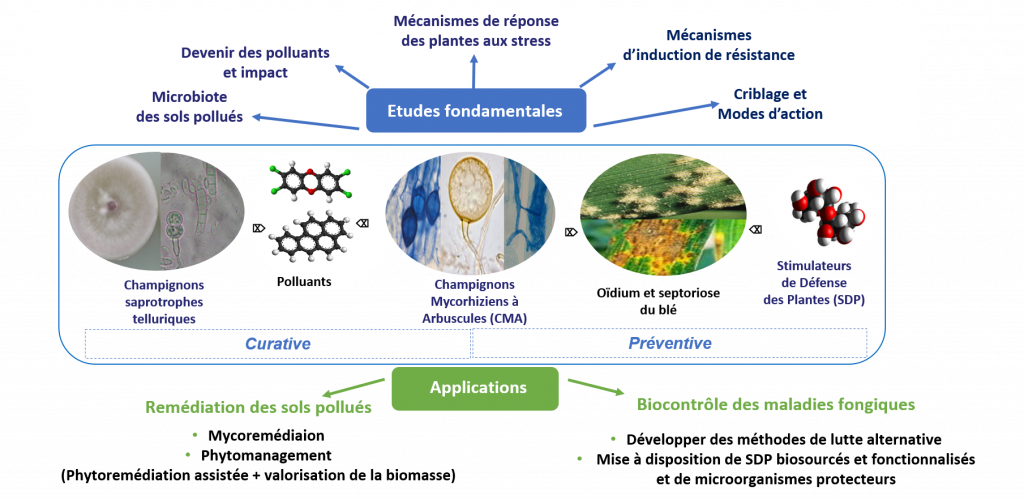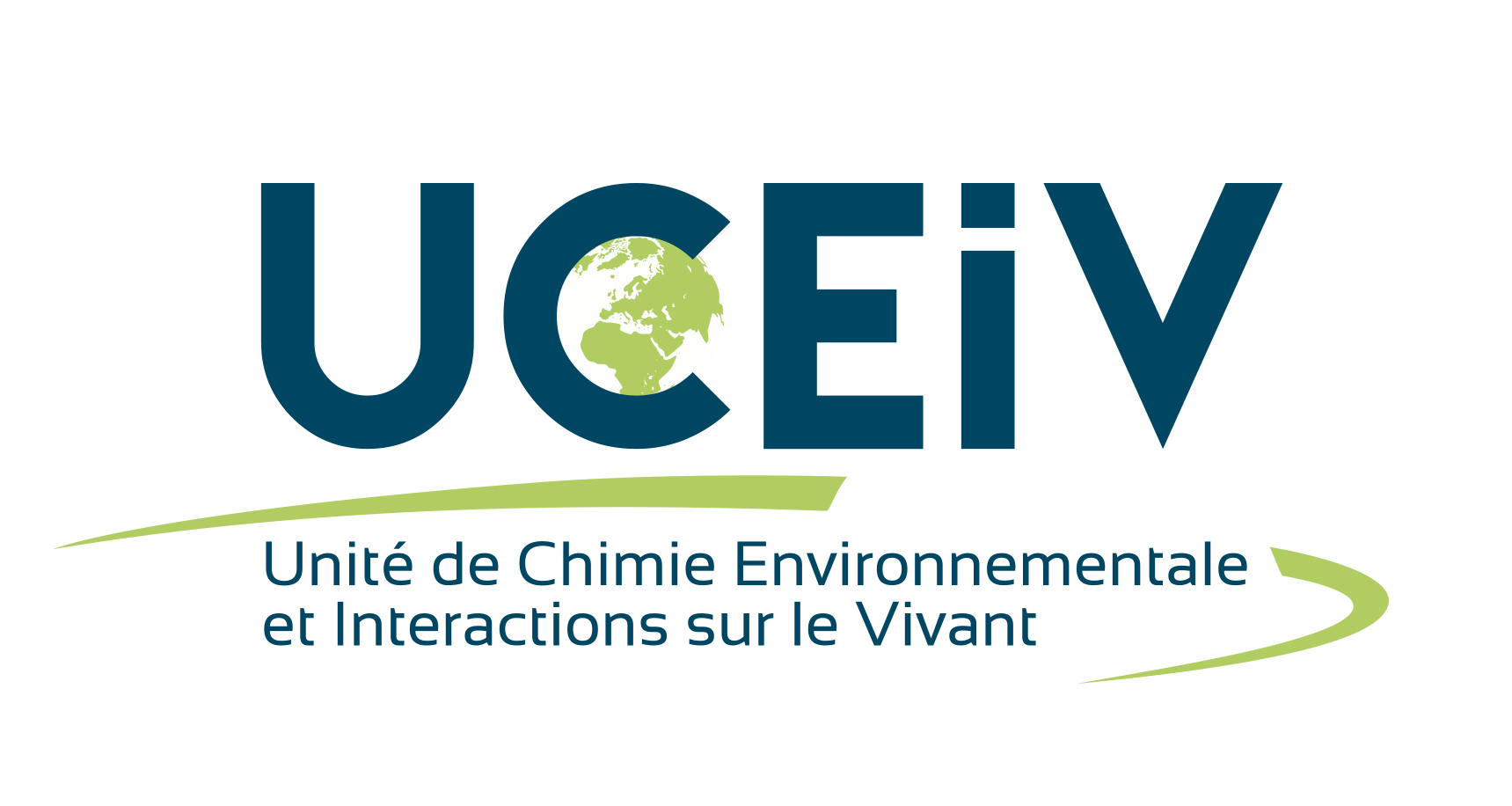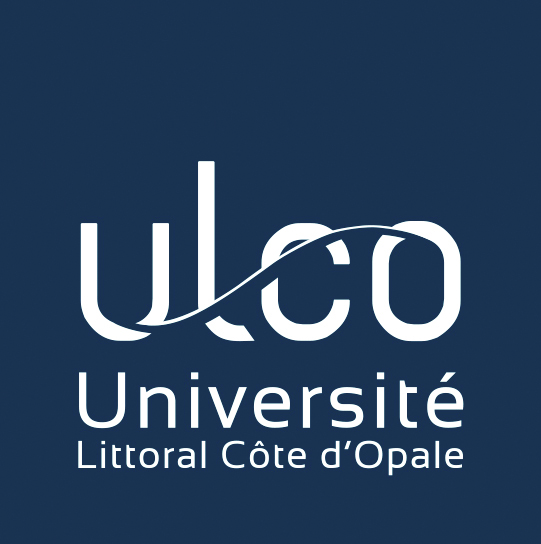Activités de recherche
Les activités de recherche de l’équipe IPCR s’articulent autour de deux volets, qui s’appuient sur ses compétences en mycologie, notamment sur les interactions plantes/champignons aussi bien symbiotiques que phytopathogènes et sur des approches de physiologie, de cytologie, de biochimie, de biologie moléculaire et d’écologie microbienne.

1 – Biocontrôle des maladies fongiques foliaires du blé
Cette thématique de recherche vise à développer de nouvelles stratégies de biocontrôle et de lutte durable contre les champignons parasites du blé, par l’utilisation de Stimulateurs de Défense des Plantes (SDPs) et/ou de microorganismes bénéfiques bactériens (Plant Growth-Promoting Rhizobacteria) ou fongiques (Plant Growth-Promoting Fungi) comme les champignons mycorhiziens à arbuscules et/ou de biostimulants en protection des plantes. Nos études portent sur deux pathosystèmes en particulier, blé/Blumeria graminis f.sp. tritici (agent de l’oïdium) et blé/Zymoseptoria tritici (agent de la septoriose). L’étude des réactions de défense chez le blé et l’optimisation de l’efficacité protectrice des SDPs en réponse à divers facteurs environnementaux pouvant influencer la mise en place d’une telle protection (génotype du blé, statut nutritionnel de la plante, microbiote du sol, changements climatiques,…) constituent les principaux objectifs de nos travaux.
2- Phytomanagement et Bioremédiation de sols contaminés.
Cette thématique de recherche vise à développer des méthodes alternatives, douces et durables, de remédiation et de gestion des sols contaminés.
Dans le cas du phytomanagement, la faisabilité, l’efficacité et la pérennité des principales phytotechnologies (phytostabilisation, phyto/rhizodégradation et phytoextraction) sont à l’étude de l’échelle du laboratoire dans des conditions contrôlées à celle des sites ateliers in situ (démonstrateurs).
il s’agit (1) d’étudier les performances de différentes espèces végétales et des amendements, notamment biologiques à base de champignons mycorhiziens à arbuscules, dans le devenir (mobilité, transfert, dissipation) des polluants organiques (ex : HAP, dioxines/furanes, alcanes) et inorganiques (éléments traces), (2) de développer des filières de valorisation non alimentaire de la phytomasse produite sur sols pollués, (3) de suivre l’influence des phytotechnologies sur la refonctionnalisation des sols contaminés, notamment via la caractérisation de leur microbiote et (4) d’évaluer les risques environnementaux et sanitaires après traitement.
De façon complémentaire, la bioremédiation consiste à exploiter, en particulier, la diversité des champignons saprotrophes dans le cadre de la biodégradation des polluants organiques tels que les HAP, les dioxines/furanes et les polluants émergents non seulement dans le sol mais aussi dans d’autres matrices (eaux, sédiments, effluents gazeux, biogaz). Ces travaux visent à étudier les mécanismes impliqués dans la dégradation des polluants organiques (disponibilité, transport et incorporation, dégradation), et l’intérêt d’utiliser les polysaccharides naturels (amidons modifiés) comme agents de solubilisation de ces polluants.
Membres de l’équipe
PERSONNELS PERMANENTS | |
BOURDON-FACON Natacha | AI |
| CHEVALIER Wilfried | MCF |
Pr | |
PR | |
LARUELLE Frédéric | IR |
PR | |
MCF | |
RAFIN Catherine | MCF-HDR |
MCF | |
IR | |
VEIGNIE Etienne | MCF |
PERSONNELS NON-PERMANENTS | |
Papa Mamadou Sitor NDOUR | Post-Doc |
Julien LANGRAND | ATER |
Collaborations scientifiques
Régionales :
- BioGAP, Institut Charles Viollette – ISA de Lille
- ProBIOGEM, Institut Charles Viollette –Université de Lille
- Laboratoire Génie Civil et géoEnvironnement, Université de Lille
- UMRT-INRAE 1158 BioEcoAgro – BIOPI – Université de Picardie Jules Verne
- Unité Transformations & Agroressources (ULR7519) – Université d’Artois
- UMR Transformation Intégrée de la Matière Renouvelable (TIMR), Ecole Supérieure de Chimie Organique et Minérale (ESCOM), Université de Technologie de Compiègne
- AGHYLE, Institut Polytechnique UniLaSalle, Beauvais
Nationales :
- Unité de Recherche Vigne et Vin de Champagne, URCA à Reims
- UMR Agroécologie, INRA de Dijon
- Unité Technologie Propres et Economie Circulaire (TPEC) – NERIS
- INRAE, SVQV, UMR A 1131 – Université de Strasbourg
Internationales :
- Laboratoire de Recherche en Développement Durable et Santé – Université Cadi Ayyad – Marrakech – Maroc
- Laboratoire Biotechnologie Végétale et Agrophysiologie des Symbioses – Université Cadi Ayyad – Marrakech – Maroc
- Laboratoire d’Amélioration Génétique des Plantes, Université d’Annaba (Algérie)
- Université des Sciences et de la Technologie Houari Boumédiène (USTHB, Algérie)
- Université de Djelfa (Algérie)
- Helmholtz Zentrum München – German Research Centre for Environmental Health, Institute of Soil Ecology, (Allemagne)
- Laboratory of Phytopathology, Université de Gand (Belgique)
- Unité de Chimie Biologique Industrielle, Université de Liège (Gembloux Agro Bio Tech) (Belgique)
- Laboratoire de Mycologie, Université de Louvain-la-Neuve (Belgique)
- Agriculture et Agroalimentaire (Ottawa)
- IRBV (Montréal)
- Université de Montréal (Canada)
- Faculté d’Agronomie, Université Saint-Esprit de Kaslik, université Libanaise (Liban)
- Université Vasile Alecsandri de Bacau, Roumanie
- Laboratoire de Génétique et Amélioration des Plantes, INAT de Tunis, Centre National de la Recherche en Agriculture Oasienne (Tunisie)
- Centre National de la Recherche en Agriculture Oasienne (Tunisie)
- Laboratory of Plant Pathology, Federal University of Santa Catarina, Florianópolis (Brésil).
Thèses en cours
Prénom Nom | Période | Titre |
| Julien Langrand | 2020-2023 | Phytomanagement au profit de la refonctionnalisation des sols pollués et des services écosystémiques : optimisation de la filière huiles essentielles dans le cadre de la bioéconomie |
| Mathieu Delaeter | 2021-2024 | Développement de marqueurs moléculaires spécifiques de l’induction de la résistance du blé en réponse à l’inoculation mycorhizienne pour lutter contre deux maladies fongiques : la septoriose et l’oïdium |
| Camille Carton | 2021-2024 | PROposition de nouvelles MOlécules BIOsourcées, d’origine végétale, dans la lutte contre les maladies des plantes |
Mathie Craquelin | 2022-2025 | Le Chitosane et ses dérivés : vers de nouveaux actifs biosourcés pour le biocontrôle |
Paola Villanueva Rosales | 2023-2026 | Développement des biostimulants pour les grandes cultures agricoles et maraîchères |
Contrats de Recherche
Projets Internationaux
- 2021-2024 : Projet PHC-TOUBKAL : Apport de l’inoculation mycorhizienne dans la production des huiles essentielles chez quelques PAM de la région de Marrakech, en collaboration avec un partenaire marocain : A. Qaddoury, Université Cadi Ayyad.
- 2016-2021 : Projet INTERREG V France-Flandres-Wallonie, , « Portefeuille de projets : SMARTBIOCONTROL (26 partenaires issus de laboratoires universitaires, de centres de recherche ou de syndicat d’agriculteurs).
- Projet BIOSCREEN : « Nouvelle molécules biosourcées et multifonctionnelles pour le contrôle des agents phytopathogènes des cultures de la région transfrontalière. » Certaines seront issues de CMA.
- Projet BIOPROTECT : « La protection biologique dans la pratique : optimisation de l’efficacité dans le champ de (nouvelles) pesticides biologiques ». Différentes espèces de CMA seront testées pour leur potentiel protecteur contre l’oïdium et la septoriose du blé.
- 2016-2019 : Projet ARIMNET – BACPLANTS : Vers une agriculture durable en augmentant la tolérance des plantes au stress biotique dans le cadre du changement climatique. (4 partenaires)
- 2017-2020: Projet CAPES-COFECUM « BIOSTIMALG » : utilisation d’algues pour une agriculture plus durable. (2 partenaires)
Projets Nationaux
- 2021-2024 : PIA – Programme d’Investissement d’Avenir – Ville Durable – Site du Crouy : : Projet de recherche scientifique et technique appliqué visant à évaluer la pertinence de l’utilisation de composts d’origine locale dans la gestion durable de sols dégradés en milieu urbain dense (5 partenaires).
- 2021-2024 : Projet DEPHYTOP (ADEME, APR GRAINE) : Démonstrateur de phytomanagement des sols contaminés par les ETM basé sur l’économie circulaire: Optimisation de la filière huiles essentielles (10 partenaires académiques, privés et institutionnels).
- 2017-2021 : Projet PHYTEO, Phytostabilization and Essential Oil (ADEME, APR GRAINE) : La production d’huiles essentielles : une filière éco-innovante de reconversion des sols historiquement pollués (6 partenaires académiques et privés).
- 2018-2022 : Projet EXTRA-Zn (ADEME, APR GRAINE) : ): Production de biomasses enrichies en Zn par phytoextraction pour l’écocatalyse (4 partenaires).
- 2015-2018 : Projet IRIS+ – FUI : Solutions innovantes pour la santé de la vigne et du blé associant applications de biostimulants et SDP à des technologies d’imagerie et d’agroéquipements. (4 partenaires privés, 3 partenaires académiques)
Projets Régionaux
- CPER BiHauts-Eco de France (2021-2027)
- CPER ECRIN (2021-2027)
- 2023-2025 : Projet MycUp (Projet Stimule STIP) : Valorisation zéro résidu du support de pousse ligno-cellulosique de champignons comestibles : utilisation en biocontrôle et biostimulation.
- 2022-2025 : Projet PROZYMO (Projet Stimule) : Production par voie enzymatique de nouvelles molécules de défense des plantes.
- 2018-2024 : Projet MINIPEST : Minimisation de l’utilisation des Pesticides en systèmes de grandes cultures et cultures légumières en Hauts-de-France. Projet DEPHY EXPE. (8 partenaires)
- 2016-2022 : Projet CPER « ALIBIOTECH Agro-alimentaire et Biotechnologie ».
WP 1. Caractérisation de l’interaction de la plante avec son environnement.
WP 2. Activités biologiques de biomolécules et métabolites secondaires issues de plantes et/ou de micro-organismes.
- 2019-2021 : Projet A2U : ULCO/UPJV. L’interaction tripartite comme moyen de lutte alternative contre l’oïdium et la septoriose du blé, TRIPLET.
- 2022 : Projet VANIFUN (SFR Condorcet) : Evaluation de dérivés de vanilline : application en protection des plantes contre des agents pathogènes fongiques.
- 2021 : Projet PHYTOFONC (SFR Condorcet) : Apport des amendements organiques dans la phytostabilisation des éléments traces métalliques et la refonctionnalisation du sol.
Contrats de recherche de gré à gré
- Contrat industriel STOLZ (2017, 2018 puis 2020) : Suivi de la qualité microbiologique (champignons et bactéries) de farines animales lors d’un processus de stérilisation innovant.
- Contrat industriel LHOIST (2019) : Etude des propriétés antifongiques, in vitro, de 2 produits (Ca(OH)2 et CaCO3) sur 3 champignons phytopathogènes du blé.
Publications récentes
- DUCOUSSO-DETREZ A., LAHRACH Z., FONTAINEZ J., LOUNES-HADJ SAHRAOUI A., HIJRI M., Cultural techniques capture diverse phosphate-solubilizing bacteria in rock phosphate-enriched habitats. Frontiers in Microbiology, 2024, ⟨10.3389/fmicb.2024.1280848⟩. ⟨hal-04443174⟩
- OFORI-AGYEMANG F., WATERLOT C., MANU J., LALOGE R., FRANCIN R., PAPAZOGLOU E., ALEXOPOULOU E., LOUNES-HADJ SAHRAOUI A., TISSERAND B., MENCH M., BURGES A., OUSTIERE N., Plant testing with hemp and miscanthus to assess phytomanagement options including biostimulants and mycorrhizae on a metal-contaminated soil to provide biomass for sustainable biofuel production. Science of the Total Environment, 2024, 912, pp.169527. ⟨10.1016/j.scitotenv.2023.169527⟩. ⟨hal-04362740⟩
- MEJRI S., GHINET A., MAGNIN-ROBERT M., RANDOUX B., ABUHAIE C.-M., TISSERANT B., GAUTRET P., RIGO B., HALAMA P., REIGNAULT P., SIAH A., New plant immunity elicitors from a sugar beet byproduct protect wheat against Zymoseptoria tritici. Scientific Reports, 2023, 13 (1), p.90. ⟨10.1038/s41598-022-26800-z⟩. ⟨hal-04048754⟩
- ALLARIO T., FOURQUEZ A., MAGNIN-ROBERT M., SIAH A., GAUCHER M., MAIA-GRONDARD A., BRISSET M.-N., HUGUENEY P., REIGNAULT P., BALTENWECK R., RANDOUX B., Analysis of defense-related gene expression and leaf metabolome in wheat during the early infection stages of Blumeria graminis f.sp. tritici. Phytopathology, 2023, ⟨10.1094/PHYTO-10-22-0364-R⟩. ⟨hal-04091467⟩
- BOUCHIAT R., VEIGNIE E., KACZMAREK F., DORCHY J., FORTUNATO A.-D., RAFIN C., A Comprehensive Review of Risk Assessments of Organic Effluents in Car Workshops. Environments, 2023, 10 (12), pp.220. ⟨10.3390/environments10120220⟩. ⟨hal-04356111⟩
- BENCHERIF K., LARUELLE F., TISSERANT B., DALPE Y., LOUNES-HADJ SAHRAOUI A., Engineering Approach for Production of Arbuscular Mycorrhizal Inoculum Adapted to Saline Soil Management. Stresses, 2023, 3 (2), pp.404 – 423. ⟨10.3390/stresses3020030⟩. ⟨hal-04063461⟩
- PLATEL R., LUCAU-DANILA A., BALTENWECK R., MAIA-GRONDARD A., TRAPET P., MAGNIN-ROBERT M., RANDOUX B., DURET M., HALAMA P., HILBERT J.-L., COUTTE F., JACQUES P., HUGUENEY P., REIGNAULT P., SIAH A., Deciphering immune responses primed by a bacterial lipopeptide in wheat towards Zymoseptoria tritici. Frontiers in Plant Science, 2023, 13, pp.1074447. ⟨10.3389/fpls.2022.1074447⟩. ⟨hal-03979567⟩
- BENCHERIF K., DALPE Y., LOUNES-HADJ SAHRAOUI A., LARUELLE F., TISSERANT B., Engineering Approach for Production of Arbuscular Mycorrhizal Inoculum Adapted to Saline Soil Management. Stresses, 2023, 3 (2), pp.404 – 423. ⟨10.3390/stresses3020030⟩. ⟨hal-04344973⟩
LANGRAND J., LOUNES-HADJ SAHRAOUI A., DUCLERCQ J., RAVEAU R., LARUELLE F., BERT V., FACON N., TISSERANT B., FONTAINE J., Coriander (Coriandrum sativum) Cultivation Combined with Arbuscular Mycorrhizal Fungi Inoculation and Steel Slag Application Influences Trace Elements-Polluted Soil Bacterial Functioning. Plants, 2023, 12 (3), pp.618. ⟨10.3390/plants12030618⟩. ⟨hal-03992461⟩
- AKACHOUD O., BOUAMAMA H., FACON N., ZOUBI B., BENKEBBOURA A., GHOULAM C., QADDOURY A., LOUNES-HADJ SAHRAOUI A., LARUELLE F., Mycorrhizal Inoculation Improves the Quality and Productivity of Essential Oil Distilled from Three Aromatic and Medicinal Plants: Thymus satureioides, Thymus pallidus, and Lavandula dentata. Agronomy, 2022, 12 (9), pp.2223. ⟨10.3390/agronomy12092223⟩. ⟨hal-04063464⟩
- VELHO A., DALLASTA P., DE BORBA M., MAGNIN-ROBERT M., REIGNAULT P., SIAH A., STADNIK M., RANDOUX B., Defense responses induced by ulvan in wheat against powdery mildew caused by Blumeria graminis f. sp. tritici. Plant Physiology and Biochemistry, 2022, 184, pp.14-25. ⟨10.1016/j.plaphy.2022.05.012⟩. ⟨hal-03673184⟩
- FONTAINE J., DUCLERCQ J., FACON N., DEWAELE D., LARUELLE F., TISSERANT B., LOUNES-HADJ SAHRAOUI A., Coriander (Coriandrum sativum L.) in Combination with Organic Amendments and Arbuscular Mycorrhizal Inoculation: An Efficient Option for the Phytomanagement of Trace Elements-Polluted Soils. Microorganisms, 2022, 10 (11), pp.2287. ⟨10.3390/microorganisms10112287⟩. ⟨hal-03881486⟩
- VEIGNIE E., RAFIN C., Efficiency of Penicillium canescens in Dissipating PAH in Industrial Aged Contaminated Soil Microcosms and Its Impact on Soil Organic Matter and Ecotoxicity. Processes, 2022, 10 (3), pp.532. ⟨10.3390/pr10030532⟩. ⟨hal-03689595⟩
- EL HOUDA RAOUANI N., CLAVERIE E., RANDOUX B., CHAVERIAT L., YASEEN Y., YADA B., MARTIN P., CABRERA J. C., JACQUES P., REIGNAULT P., MAGNIN-ROBERT M., LOUNES – HADJ SAHRAOUI A., Bio-Inspired Rhamnolipids, Cyclic Lipopeptides and a Chito-Oligosaccharide Confer Protection against Wheat Powdery Mildew and Inhibit Conidia Germination. Molecules, 2022, 27 (19), pp.6672. ⟨10.3390/molecules27196672⟩. ⟨hal-03806266⟩
- PLATEL R., SAWICKI M., ESMAEEL Q., RANDOUX B., TRAPET P., EL GUILLI M., CHTAINA N., ARNAULD S., BRICOUT A., ROCHEX A., BOURDON N., HALAMA P., JACQUARD C., BARKA E. A., REIGNAULT P., MAGNIN-ROBERT M., SIAH A., Isolation and Identification of Lipopeptide-Producing Bacillus velezensis Strains from Wheat Phyllosphere with Antifungal Activity against the Wheat Pathogen Zymoseptoria tritici. Agronomy, 2022, 12 (1), pp.95. ⟨10.3390/agronomy12010095⟩. ⟨hal-03511669⟩
- PLATEL R., LUCAU-DANILA A., BALTENWECK R., MAIA-GRONDARD A., CHAVERIAT L., MAGNIN-ROBERT M., RANDOUX B., TRAPET P., HALAMA P., MARTIN P., HILBERT J.-L., HOFTE M., HUGUENEY P., REIGNAULT P., SIAH A., Bioinspired Rhamnolipid Protects Wheat Against Zymoseptoria tritici Through Mainly Direct Antifungal Activity and Without Major Impact on Leaf Physiology. Frontiers in Plant Science, 2022, 13, pp.878272. ⟨10.3389/fpls.2022.878272⟩. ⟨hal-03704459⟩
- Ducousso-Détrez, A.; Fontaine, J.; Lounès-Hadj Sahraoui, A.; Hijri, M. Diversity of Phosphate Chemical Forms in Soils and Their Contributions on Soil Microbial Community Structure Changes. Microorganisms, 2022, 10, 609. https://doi.org/10.3390/microorganisms10030609.
- RAVEAU, R.; FONTAINE, J.; SOLTANI, A.; MEDIOUNI BEN JEMÂA, J.; LARUELLE, F.; LOUNÈS-HADJ SAHRAOUI, A. : In Vitro Potential of Clary Sage and Coriander Essential Oils as Crop Protection and Post-Harvest Decay Control Products. Foods 2022, 11, 312, 2022. https://doi.org/10.3390/ foods11030312.
- M.C. de BORBA, A.C. VELHO, M.B. de FREITAS, M. HOLVOET, A. MAIA-GRONDARD, R. BALTENWECK, M. MAGNIN-ROBERT, B. RANDOUX, J.-L. HILBERT, Ph REIGNAULT, P. HUGUENEY, A. SIAH, M.J. STADNICK. A laminarin-based formulation protects wheat against Zymoseptoria tritici via direct antifungal activity and elicitation of host defense-related genes. Plant Disease, 2022, 106 (5), pp.1408-1418. ⟨10.1094/PDIS-08-21-1675-RE⟩. ⟨hal-03623999⟩
- M. JERBI, S. LABIDI, F. LARUELLE, B. TISSERANT, F. BEN JEDDI, A. LOUNÈS-HADJ SAHRAOUI. : Mycorrhizal biofertilization improves grain yield and quality of Hulless Barley (Hordeum vulgare ssp. nudum L.) under water stress conditions. Journal of Cereal Science, 2022, 104, pp.ID 103436. ⟨10.1016/j.jcs.2022.103436⟩. ⟨hal-04345905⟩
- M. JERBI, S. LABIDI, F. LARUELLE, B. TISSERANT, Y. DALPE, A. LOUNES-HADJ SAHRAOUI, F. BEN JEDDI. : Contribution of native and exotic arbuscular mycorrhizal fungi in improving the physiological and biochemical response of Hulless Barley (Hordeum vulgare ssp. nudum L.) to drought. Journal of Soil Science and Plant Nutrition, 2022, 22 (2), pp.2187 – 2204. ⟨10.1007/s42729-022-00802-2⟩. ⟨hal-04063463⟩
- A. LOUNES-HADJ SAHRAOUI, M. CALONNE-SALMON, S. LABIDI, H. MEGLOULI, J. FONTAINE ; Chapter 3 : Arbuscular mycorrhizal fungi-assisted phytoremediation: Concepts, challenges, and future perspectives. In : Assisted PhytoremediationEdited by V. Pandey. Elsevier. 2022. Pp49-100. https://doi.org/10.1016/C2019-0-04894-7.

